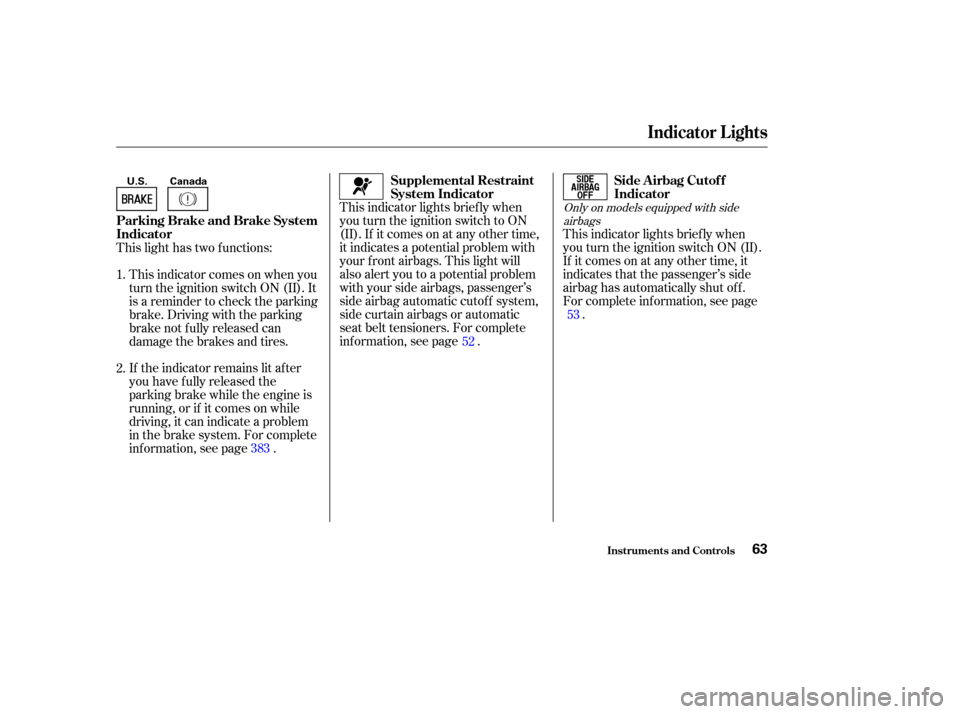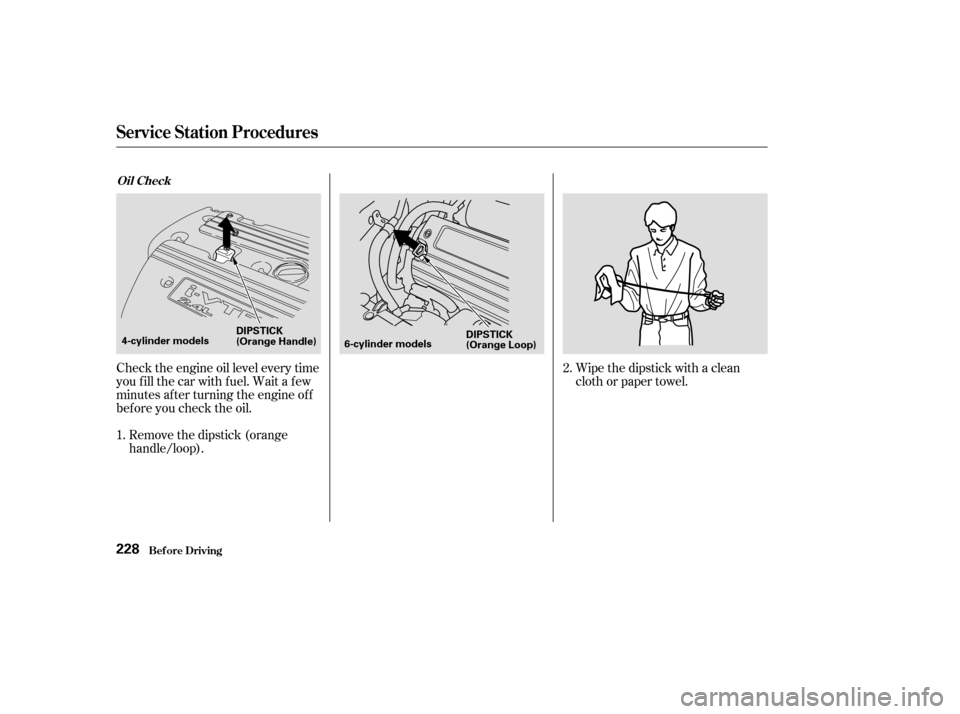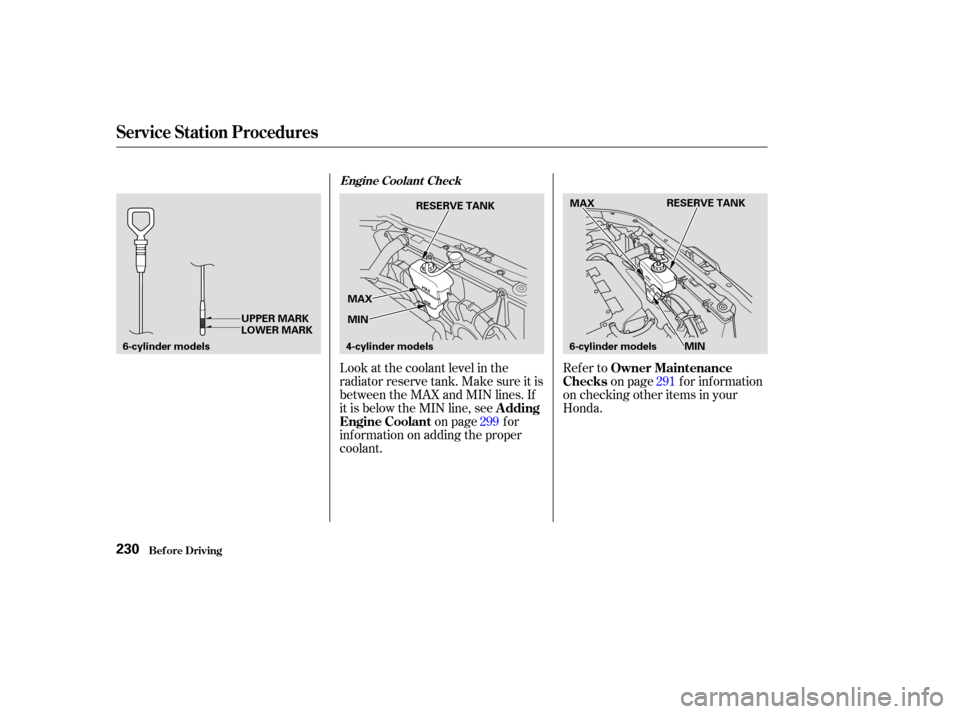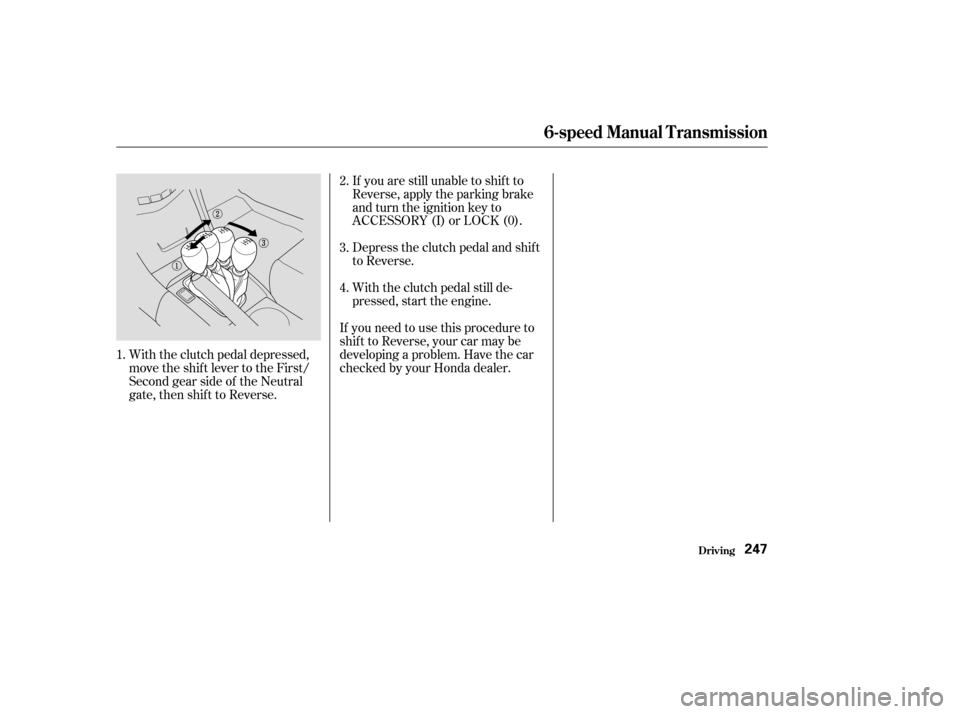check engine HONDA ACCORD COUPE 2003 CL7 / 7.G Owners Manual
[x] Cancel search | Manufacturer: HONDA, Model Year: 2003, Model line: ACCORD COUPE, Model: HONDA ACCORD COUPE 2003 CL7 / 7.GPages: 429, PDF Size: 6.42 MB
Page 56 of 429

CONT INUED
If you see any of these indications,
your airbags may not deploy, your
passenger’s side airbag automatic
cutof f system may not work properly,
or your seat belt tensioners may not
work when you need them. See your
Honda dealer as soon as possible.
If the light comes on at any other
time, or does not come on at all, you
should have the system checked by
your dealer. For example:
If the SRS indicator light does not
come on after you turn the ignition
switch to ON (II).
If the light stays on after the
engine starts.
If the light comes on or f lashes on
andoff whileyoudrive. This light alerts you that
the passenger’s side airbag
has been automatically shut off.
To reduce the risk of injury f rom an
inf lating side airbag, your car has an
automatic cutoff system for the
passenger’s side airbag.
It does not mean there is a problem
with your side airbags. It means that
thesideairbagcutoff systemhas
activated to prevent the side airbag
f rom deploying.
Only on models equipped with side
airbags
Driver and Passenger Saf ety
How the Side Airbag Cutof f
Indicator L ight Works
Additional Inf ormation About Your Airbags
53
Ignoring the SRS indicator light
can result in serious injury or
death if the airbags, cutoff
system, or tensioners do not
work properly.
Have your vehicle checked by a
dealer as soon as possible if
the SRS light alerts you to a
potential problem.
Page 66 of 429

This indicator lights brief ly when
you turn the ignition switch ON (II).
If it comes on at any other time, it
indicates that the passenger’s side
airbag has automatically shut off.
For complete inf ormation, see page.
This indicator lights brief ly when
you turn the ignition switch to ON
(II). If it comes on at any other time,
it indicates a potential problem with
your f ront airbags. This light will
also alert you to a potential problem
with your side airbags, passenger’s
side airbag automatic cutoff system,
side curtain airbags or automatic
seat belt tensioners. For complete
inf ormation, see page .
This indicator comes on when you
turn the ignition switch ON (II). It
is a reminder to check the parking
brake. Driving with the parking
brake not f ully released can
damage the brakes and tires.
This light has two f unctions:
If the indicator remains lit after
you have f ully released the
parking brake while the engine is
running, or if it comes on while
driving, it can indicate a problem
in the brake system. For complete
inf ormation, see page .
1.
2.
53
383 52
Only on models equipped with side
airbags
Supplemental Restraint
System Indicator Side A irbag Cutof f
Indicator
Parking Brake and Brake System
Indicator
Indicator L ights
Inst rument s and Cont rols63
U.S. Canada
Page 73 of 429

This meter shows the number of
miles (U.S.) or kilometers (Canada)
driven since you last reset it.This shows the temperature of the
engine’s coolant. During normal
operation, the pointer should rise
from the bottom white mark to about
the middle of the gauge. In severe
driving conditions, such as very hot
weather or a long period of uphill
driving, the pointer may rise into the
upper half of the gauge. If it reaches
the red (Hot) mark, pull safely to the
side of the road. Turn to page f or
instructions and precautions on
checking the engine’s cooling
system.This shows how much f uel you have.
It is most accurate when the car is on
level ground. It may show slightly
more or less than the actual amount
whenyouaredrivingoncurvyor
hilly roads.
The needle returns to the bottom
after you turn off the ignition. The
gauge shows the f uel level reading
immediately af ter you turn the
ignition switch back ON (II).
There are two trip meters: Trip A
and Trip B. Switch between these
displays and the odometer/outside
temperature display by pressing the
Select/Reset knob repeatedly. Each
trip meter works independently, so
you can keep track of two dif f erent
distances.
When you turn the ignition switch to
ON (II), what you last selected is
displayed.
To reset a trip meter, display it, and
then press and hold the Select/Reset
knob until the number resets to ‘‘0.0’’. 376
Trip Meter
Temperature GaugeFuel Gauge
Gauges
Inst rument s and Cont rols70
Avoid driving with an extremely low
f uel level. Running out of f uel could
cause the engine to misf ire, damaging
the catalytic converter.
Page 108 of 429

If your car’s battery is disconnected
or goes dead, or the driver’s window
f use is removed, the AUTO f unction
will be disabled. The power window
system needs to be reset af ter
reconnecting the battery or installing
the f use. You should do the f ollowing.Start the engine. Push down on
the driver’s window switch until
the window is f ully open.
Pull back on the driver’s window
switch to close the window
completely, then hold the switch
f or a second or two more.
If the power windows do not operate
properly af ter resetting, have your
car checked by a Honda dealer. The power window system has a key-
of f delay f unction. The windows will
stilloperateforuptotenminutes
after you turn off the ignition.
Opening either door cancels the
delay function. You must turn the
ignition switch ON (II) again before
you can raise or lower the windows.
1.
2.
Power Windows
Inst rument s and Cont rols105
Page 226 of 429

Bef ore you begin driving your Honda,
youshouldknowwhatgasolineto
use, and how to check the levels of
important f luids. You also need to
know how to properly store luggage
or packages. The inf ormation in this
section will help you. If you plan to
add any accessories to your car,
please read the inf ormation in this
section f irst..............................
Break-in Period .224
.........................................
Gasoline .224
.........
Service Station Procedures . 225
................
Filling the Fuel Tank . 225
....................
Opening the Hood .226
...............................
Oil Check .228
.........
Engine Coolant Check . 230
...............................
Fuel Economy .231
............................
Car Condition .231
...........................
Driving Habits .231
...
Accessories and Modif ications . 232
.............................
Carrying Cargo .234
Bef ore Driving
Bef ore Driving223
Page 231 of 429

Check the engine oil level every time
you f ill the car with f uel. Wait a f ew
minutes af ter turning the engine of f
bef ore you check the oil.Wipe the dipstick with a clean
cloth or paper towel.
Remove the dipstick (orange
handle/loop).
1. 2.
Service Station Procedures
Bef ore Driving
Oil Check
228
4-cylinder models
6-cylinder models
DIPSTICK
(Orange Handle)
DIPSTICK
(Orange Loop)
Page 233 of 429

Refer toon page f or inf ormation
on checking other items in your
Honda.
Look at the coolant level in the
radiator reserve tank. Make sure it is
between the MAX and MIN lines. If
it is below the MIN line, see
on page f or
inf ormation on adding the proper
coolant. 299 291
Service Station Procedures
Bef ore Driving
Owner Maintenance
Checks
A dding
Engine Coolant
Engine Coolant Check
230
UPPER MARK
LOWER MARK RESERVE TANK
4-cylinder models MIN MAX MAX
RESERVE TANK
6-cylinder models MIN
6-cylinder models
Page 234 of 429

A cold engine uses more f uel than a
warm engine. It is not necessary to
‘‘warm-up’’ a cold engine by letting it
idle f or a long time. You can drive
away in about a minute, no matter
how cold it is outside. The engine
will warm up f aster, and you get
better f uel economy. To cut down on
the number of ‘‘cold starts,’’ try to
combine several short trips into one.
You can improve f uel economy by
driving moderately. Rapid acceler-
ation, abrupt cornering, and hard
braking use more f uel.
Always drive in the highest gear that
allows the engine to run and acceler-
ate smoothly.
The air conditioning puts an extra
load on the engine which makes it
usemorefuel.Turnoff theA/Cto
cut down on air conditioning use.
Use the f low-through ventilation
when the outside air temperature is
moderate.
The condition of your car and your
driving habits are the two most
important things that affect the fuel
mileage you get.
Always maintain your car according
to the maintenance schedule. This
will keep it in top operating condition.
Depending on traf f ic conditions, try
to maintain a constant speed. Every
time you slow down and speed up,
your car uses extra f uel. Use the
cruise control, when appropriate, to
increase f uel economy.
An important part of that mainte-
nance is the
(see page ). For
example, an underinf lated tire
causes more ‘‘rolling resistance,’’
which uses f uel. It also wears out
f aster, so check the tire pressure at
least monthly.
In winter, the build-up of snow on
your car’s underside adds weight and
rolling resistance. Frequent cleaning
helps your f uel mileage and reduces
thechanceof corrosion. 291 Driving Habits
Owner Maintenance
Checks Car Condition
Fuel Economy
Bef ore Driving231
Page 243 of 429

Make sure all windows, mirrors,
and outside lights are clean and
unobstructed. Remove f rost, snow,
or ice.
Check that the hood and trunk are
f ully closed.Check the adjustment of the seat
(see page ).
Check the adjustment of the
inside and outside mirrors (see
page ).
Check the adjustment of the
steering wheel (see page ).
Make sure the doors are securely
closed and locked.
Fasten your seat belt. Check that
your passengers have f astened
their seat belts (see page ).Turn the ignition switch ON (II).
Check the indicator lights in the
instrument panel.
Start the engine (see page ).
Check the gauges and indicator
lights in the instrument panel (see
page ).
Check that any items you may be
carrying with you inside are stored
properly or f astened down
securely. Visually check the tires. If a tire
looks low, use a gauge to check its
pressure.
Youshoulddothefollowingchecks
and adjustments every day bef ore
you drive your car.
3.2.
1.
4. 5.
6.
7.
8.
9. 11.
12. 10.
16 61
94
108 80 241
Preparing to Drive
Driving240
Page 250 of 429

With the clutch pedal depressed,
move the shift lever to the First/
Second gear side of the Neutral
gate, then shif t to Reverse.If you are still unable to shif t to
Reverse, apply the parking brake
and turn the ignition key to
ACCESSORY (I) or LOCK (0).
Depress the clutch pedal and shif t
to Reverse.
With the clutch pedal still de-
pressed, start the engine.
If you need to use this procedure to
shif t to Reverse, your car may be
developing a problem. Have the car
checked by your Honda dealer.
1. 2.
3.
4.
6-speed Manual T ransmission
Driving247